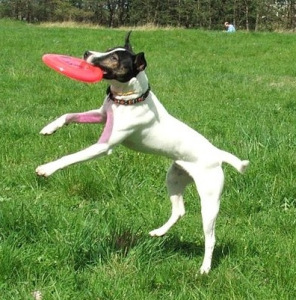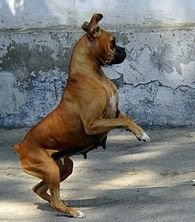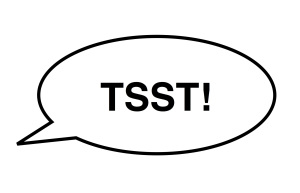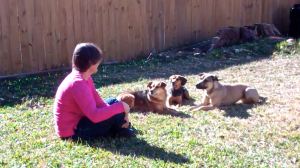Some dog trainers who use tools such as shock, prong, or slip collars, or startle the dog with thrown objects or loud noises, claim that these things are done only to “get the dog’s attention.” They may further insist that the dog is not hurt, bothered, or scared.
This sounds like the Holy Grail of dog training. It’s the Magical Attention Signal! It can get your dog’s attention, get him to do something, or stop doing something, all rolled into one. You don’t have to use those pesky treats or toys, and it certainly doesn’t hurt or bother the dog!
Gosh, who wouldn’t want that? Life would be so easy with the Magical Attention Signal!
Unfortunately, the Magical Attention Signal is utter nonsense.
Nonsense Clue #1
We almost never want only our dog’s attention.
Let’s say that your Magical Attention Signal is tossing a lightweight coaster towards your dog. Your dog doesn’t particularly care about coasters. (Folks with disc-crazy dogs, hang on, I’ll get to you.) So you toss the coaster and the dog looks up. Yay, success! You’ve got the dog’s attention. Mission accomplished!
Um, no. Of course we don’t want only the dog’s attention. When we want their attention, it’s for a reason. The reason is almost always one of two things: to get them to do something or stop doing something. Getting their attention is only the bare beginning.
Nonsense Clue #2
Non-predictive stimuli are subject to habituation.
Habituation: A decrease in response following repeated exposure to a non-threatening stimulus.–Klein, Thorne: (2006) Biological Psychology
Virtually all of us have experienced habituation to something that was initially novel. Let’s say you move to a new house. It’s barely within earshot of an elevated train or metro track. When you first move in, you notice the sound of the train regularly: maybe a whistle, or just the rumble.
At first it gets your attention. However, it gradually sinks in that there are no relevant consequences to that sound for you. The train schedule doesn’t affect vehicle or pedestrian traffic in any way. You don’t have to arrange your day around it. None of your loved ones ride it or work for the railroad. The noise is faint and there aren’t any noxious fumes. It doesn’t predict danger. In fact the train noise doesn’t predict anything for you, good or bad.
So what happens to the stimulus of train noise? Habituation. You stop noticing it. It fades into the background. Our minds sift through stuff all the time to determine predictors of good and bad consequences. Things to seek and things to avoid. Low-intensity stimuli with no consequences fall to the bottom of the priority stack.*
Animals, including dogs, do this sifting too. Some dogs are noticeably good at it, like my Clara, who often knows my behavior patterns better than I do. And when you think about it, loads of the stuff we humans do has some kind of predictive value to our dogs. Turning on the TV. Getting dressed. Opening the refrigerator. Sighing. Even pulling down a book from the bookshelf.
I had a hard time thinking of a regularly occurring non-predictive stimulus in my life with my dogs, but here’s one. For my own dogs, the automatic switching on and off the the central heating and air means nothing. They hear it intermittently all day long, but it is just background noise to them. If the temperature weren’t well controlled, or if one of them was extremely hot- or cold-natured, she might start to notice and take the opportunity to go lie next to the air vent. Then the sound of the heat and air clicking on would become predictive, and start rising up in the stack of “things to notice.”
So the upshot is that if we want our dogs to keep responding to a stimulus, it generally has to be quite strong in itself, or have a consequence. Good or bad, your choice. But not neutral.
What Really Happens?
So how might our thrown coaster stimulus work? We have determined that if it were non-predictive, it probably wouldn’t continue to get the dog’s attention. So if it works consistently to get the dog’s attention, what’s going on?
There are four relevant possibilities:
- Yay!
Having a coaster suddenly land nearby could be intrinsically desirable to the dog. Maybe you have a loopy goofy retriever and he loves having something thrown near him, even if it’s just a coaster. He probably grabs it and plays with it. However, it may have failed as an attention-getting device. He’s playing with the toy, not looking up at you. And if you threw it when he was doing something you didn’t like, you would have accidentally reinforced the bad behavior. “Yay! I got a toy when I barked at Grandma!” (This can happen when people try to interrupt or punish with squirt bottles. Some dogs think being squirted is wonderful.)
- Yipes!
It could be intrinsically aversive to the dog. I would wager that this is the case for many dogs, especially at first. Something flying through the air, appearing suddenly close and making a noise could startle them. Some dogs would habituate to it, and some might never do so. If they didn’t habituate, this could work as a way of getting your dog to pay attention to you. There’s a big drawback though: that startled, fearful response would likely become associated with you. You become the scary person who throws stuff.
- It could predict something desirable for the dog.
Maybe your dog is not turned on by coasters. But what if, every time you tossed the coaster, you then threw a treat or a toy? The dog would quickly learn that the coaster toss predicted great stuff (in the same way that clickers are typically used). If you were to toss the coaster a number of times, pairing it with good stuff, after the dog learned to the association you could use it to interrupt undesirable behavior. This is the principle of the “positive interrupter.” But you don’t have to throw anything. If you are close enough to toss a coaster, a simple noise or word would do. And it’s pretty clear that the promoters of the Magical Attention Signal are not using it this way.
- It could predict something aversive for the dog. Like saying “Tsst!,” which is
favored by some TV personalities. It could predict a kick or a jab in the neck. Or something less dramatic, like being yelled at or handled roughly. This might not have been the trainer’s or owner’s intent from the start. But if the startling effect of the thrown coaster wears off (version #2), a stronger consequence will need to be added. Then the thrown coaster would become either a punishment marker (“Fido, you are about to get it”) or a threat (“Fido–hop to it or you are going to get it”). This is also how most shock collar training works. When a trainer brags that he uses only an extremely low, non-aversive level, that is because the dog has already been taught that the shock can easily be escalated if he doesn’t comply. Otherwise we are left only with the Magical Attention Signal.**
By the way, #4 illustrates the concept of the “punishment callus.” One of the paradoxical problems with using an aversive is that most people want to start out light. But if you try that on strongly entrenched dog behaviors like barking, digging, or jumping up, the behavior may well prove to be too strong. Then you will be in the position of having to escalate. And often the dog’s ability to tolerate the aversive will escalate right alongside.
No Magical Attention Signal
Many promoters of aversive tools to use in dog training don’t want to say that they ever hurt or scare or startle or nag or bully dogs. And our mythology about dogs is so strong that most of us want to believe them. Hence, the lure of the magic signal that works all by itself, with no other consequences. I hope this post will bolster your “nonsense detector.” Behavior is driven by consequences. If no change in consequences occurs, there is no reason for a behavior to change.
If someone says that Tool A, B, or C is designed to “get the dog’s attention,” ask them what happens next. Once they get the dog’s attention, how do they actually get the dog to do something or stop doing something? Also ask them what happens if the “painless” tool fails to get the dog’s attention.
The Magical Attention Signal is not going give any lasting help on its own. Learning theory and common sense (if only we could apply it when we think about dogs!) tell us that behavior has consequences. We take actions for a reason. We act to get stuff we want. To avoid stuff we don’t like. All creatures with a brain stem, and more primitive creatures as well, from what I hear, do this.
Rapt attention in the backyard
But the good news: if you keep conscious control of the reinforcers in your life with your dogs, use those reinforcers to strengthen behaviors you like, teach alternatives to behaviors that you don’t, you will have a head start on getting great attention from your dog.
All photos except the one of my dog Zani and the one with my three dogs are courtesy of Wikimedia Commons. The boxer photo was cropped.
* This is a simplification of habituation. The extent of habituation depends on several characteristics of the stimulus and organism. Here is a review article: Rankin, et al. [2009.] Habituation Revisited: An Updated and Revised Description of the Behavioral Characteristics of Habituation. Neurobiol Learn Mem. Sep 2009; 92(2): 135–138.
**We could also add, looking at the four quadrants, that the thrown coaster could predict the cessation of something aversive, or the removal of something good. But I think these are pretty unlikely usages.







